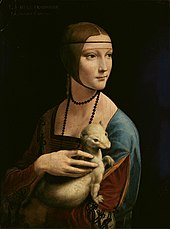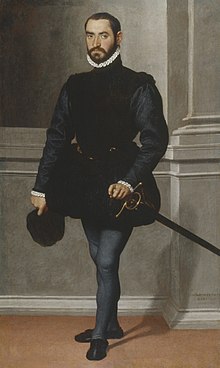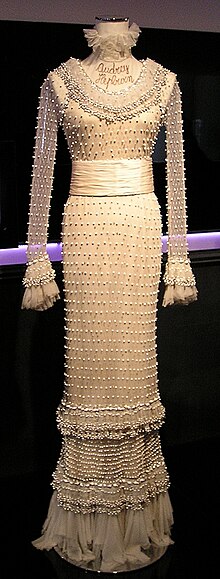History of Italian fashion
| History ofItaly |
|---|
 |
|
|
Thehistory of Italian fashionis a chronological record of the events and people that impacted and evolvedItalian fashioninto what it is today. From theMiddle Ages,Italian fashion has been popular internationally, with cities in Italy producing textiles likevelvet,silk,andwool.During the Middle Ages andRenaissance,Italian fashion for both men and women was extravagant and expensive, but the fashion industry declined during theindustrializationof Italy. Many modern Italian fashion brands were founded in the late 19th and early 20th centuries, and in the 1950s and 1960s, Italian fashion regained popularity worldwide. While many clients of Italian fashion designers are celebrities, Italian fashion brands also focus on ready-to-wear clothes.

Renaissance
[edit]Italian fashion, art, music, and philosophy flourished during the Renaissance in Italy.[1][2]The cities ofVenice,Milan,Florence,Palermo,Naples,andRomeproduced textiles such as velvet, silk, and wool.[3]Italian fashion grew in popularity and influence across Europe, and was preferred by one of the most powerful families in Italy, theMedicisof Florence.[4]In the 15th and 16th centuries, Italian fashion was influenced by the art ofMichelangelo,Leonardo da Vinci,andRaphael.[5]Italian fashion was extravagant and expensive, crafted from velvet, brocade, ribbons, and jewels.
Women's styles during the Renaissance
[edit]In the 1400s, women's fashion shifted from high-necked gowns and braided hair wrapped around the head to layered V-shaped necklines and longer braids. Gathered and pleated skirts were popular.[6][7]Women's fashion at the time could be defined by one word: fullness. While men worked to accentuate the top portion of their bodies, women did the opposite. The top and bust area was always fitted and the waist was to be accentuated as the tiniest part of the body. Then the bottom half of the body would be made to look as full as possible, with extravagant and over the top skirts. Wide and puffed sleeves were the popular styles and wealthy women often had fur lined sleeves. Clothing was not about comfort or convenience, as women would typically wear about 5 layers on an everyday basis. Women's dresses consisted of fitted garments worn underneath a belted dress, also calledgiornea.Unlike the men's, the women'sgiorneacovered their feet, and originally evolved from thehouppelande(a long, full-skirted gown with a high collar).[8]The skirts were fitted around the waist and often pleated. Earlier dresses had a slit in the front that revealed the garment underneath, and later dresses had a slit on the side. Underneath thegiornea,women wore agamurra,a long dress that had a high waistline. Some had detachable sleeves. The undergarment was a plain linen dress, called acamicia.Women wore high heels called Pianelle. Heels were worn less for fashion at the time and more for functionality. Women wore heeled shoes to keep their dresses from dragging on the damp and dirty streets.

Women's hairstyles and headdresses
[edit]Hairstyles at the time were dependent on a woman's marital status. If a woman was single, she would wear her hair down, usually in loose curls. Once women were wed, they would begin wearing their hair up, in tight braids. Popular accessories for the hair:
- Lenza-a leather cord known as a worn around the head to keep hair flat
- Trinzale-a sheer hairnet worn at the back of the head and sometimes beaded
- Coazzoni-women parted their hair in the middle and smoothed to the head with a long braid at the back, where ribbons or netting could be added.
- Wigs and False Braids
- Other hairstyles used long strips of ribbon to secure the hair and tie it into a bun.
Men's styles during the Renaissance
[edit]
During theItalian Renaissance,men wore large, fitted waistcoats underneath pleated overcoats calledgiornea,which had wide, puffy mutton sleeves and were often made frombrocade.Men wore hats likecapsandberets.Men typically wore an overcoat called acioppa,which had lining of a different color than the main fabric, a defining feature of fashion during the Italian Renaissance. Men typically worehoseor tights that emphasized their lower bodies. Men and women wore outer clothes with detachable and oftenslashedsleeves of varied designs. Wealthy people owned many different pairs of sleeves to match their overcoats and dresses.[6][7]The Renaissance changed societal attitudes toward clothing and appearance. Men in particular wanted to wear more fitted clothes to emphasize their body shape. Merchants expanded the market for apparel, and created complementary accessories such as hats, hairnets, bags, and gloves. The widespread use of mirrors, popular in Renaissance interior design and architecture, increased interest in self-image and fashion.
Men's hairstyles and headdresses
[edit]
Thebonnetwas worn by Venetians. The bonnet is a small, round or squared, brimless cap that was usually red or black and made offeltor velvet. It is unadorned and sometimes pinched in at the four corners. Slight variations in the bonnet's style were visible among the differentsocial classesand professions. For church officials and university professors, the cap had four corners or the sign of the cross. For a doctor of divinity, the cap had three corners. The cornered cap evolved into today's square trencher ormortarboarduniversity hat.
- Flat cap or beret (Popular during the first half of the 16th century).
It was often worn over a velvet coif or gold cord net and sometimes attached to a wig. Caps for daily use were made out of cloth, while fancier bonnets were made out of luxurious materials like felt, velvet,satin,taffeta,scarceness (a thin silk) and straw in the summer. The decorations used for the beret were usually white, in untrimmed ostrich, peacock, marabou and wool imitation, and plumes. Feathers held with jeweled sockets with spangles and jewels would often be sewn onto the spine. Brooches with sacred motifs were also used for decoration. Small gold ornaments in bowknots, rings, and buttons were sewn to the underside of the brim.
It was common for men in the 16th century to have a clean-shaven face along with a straight or crimped bob. Long bangs of natural hair or silk wigs were fashionable, as well.Francois Istarted the trend of short hair and beards in the Italians and the Swiss, after accidentally cutting his hair. In the 1560s, starch was invented and men started to starch their beards. From the 1570s to 1590s, men brushed the front of their hair up off their foreheads. For elegant events or occasions, men wore wigs to conceal their baldness. They would wear tilted berets attached to a wig instead of acoif.Wigs were made out of real hair.
Clerical dress
[edit]Prior to 1500, there were no rules about the color of the clerical dress. However, due to a decision in 1565 in Milan, black became the accepted color in Italy. While white remained as the pope'sbirettacolor, scarlet was accepted by the Cardinals, purple by the bishops, and black by the clerics.
Decline
[edit]In the 17th century, Italian fashion fell into a decline, while Spain, England, and France led the industry. In Europe,French fashionwas most popular. The fashion industry remained active in Italy, especially in Rome, Milan, and Florence. In the mid-19th century, cheaper silk was imported to Milan from Asia because thephylloxerapest infestation damaged silk and wine produced in Italy. After industrialization, metal, mechanical, and furniture manufacturing replaced textile production. Some of the first modern Italian fashion designers, such asBulgari,Prada,Gucci,andFerragamo,were founded in the late 19th and early 20th centuries. In the 1950s and 1960s, Italian fashion regained popularity worldwide.
During this time, the production of fabrics growth up, allowing fashion designers to have access to high-quality fabrics a century later. Three major production centers in the wool industry started to develop in Italy:Veneto,Piedmont,andTuscany.In Veneto, industrialistAlessandro Rossiset up wool factories inSchio,leading the company of his father Francesco Rossi.La Fabbrica Altawas the most notable one.[9]Meanwhile,Gaetano Marzottospecialized in fine carded and combed fabric inValdagno.In theBiella areaof Piedmont surged some of the most recognized fabric manufacturers, such as Piacenza,Reda,Rivetti,Zegna,Sella, andLoro Piana.In this region appeared the first wool association in Italy.[10]
In 1911,Lombardyconcentrated the spindles and looms of Italy. Half of them were in the region. Families such as Cantoni, Ponti, andCrespibecame influential in the industry.[10]In 1922, cotton fabrics reached 100 000 tones. It increased to 145 000 tonnes in 1940.[10]
Revival
[edit]
In the post-war, Italian handmade items were recognized as high quality and low-cost products. Italy adopted American methods of production and took advantage of preexisting connections between Italian tailors that emigrated to the United States.[11]The United States helped to Italian textile and clothing industry to integrate into the world, creating also a demand for Italian products.[11]
In Florence, Giovanni Battista Giorgini achieved the first contact between Italian fashion and American buyers. He convinced Italian designers to show their works to fashion journalists and American buyers.[11]On 12 February 1951, the Italian businessmanGiovanni Battista Giorginiheld afashion showin Florence to make Italy an international leader in fashion design.[12]In 1952,Brionistaged the first men's fashion show in history.[13]Prior to hissoiréesin 1951 to 1953, Italy had begun exporting luxury fashion goods and handbags to other nations, including the United States.[11]
The growing presence of Italy in the American market allowed an expansion of the Italian fashion industry. Exports grew by more than 150 percent from 1950 to 1956. In 1957, Italy was the main European exporter to the United States and Canada.[11]Unlike other countries leading the fashion industry, Italian lacked a center associated with a national style. Florence, Rome, and Milan disputed the title. Each urban center displayed an own tradition in craftsmanship.[11]
In 1957, textile products were the second largest retail sale group in Italy after food.[10]There were 175 000 shops specialized in sellinglinen,knitwear,socks,fabrics,ready-made clothes,shoes,jewelersand custom jewelers,milliners,furriers,andluggage.Ready-to-Wearindustry existed in Italy for a long time, but its boom surged between 1958 and 1963, during the economic miracle.[10]
In the 1960s, the handbags produced by the designerGuccidrew the attention of celebrities such asGrace Kelly,Peter Sellers,Audrey Hepburnand theFirst Ladyof the United States,Jackie Kennedy.Gucci's "GG" monogram logo became synonymous withHollywoodfashion.[14]Jackie Kennedy developed a close friendship with the Italian designerValentino Garavani,and wore his designs ever since 1965, including at her wedding toAristotle Onassis.Florence was Italy'sfashion capitalin the 1950s and 1960s, and Milan in the 1970s and 1980s, withVersace,Armani,andDolce & Gabbanaopening up their first boutiques there. Until the 1970s, Italian fashion primarily served the wealthy, similar tohaute couturein France.
In the 1970s and 1980s, Italian fashion started to concentrate on ready-to-wear clothes, such asjeans,sweaters, andminiskirts.Milan had more affordable styles for shoppers, and Florence was no longer considered the fashion capital of Italy. New clothing labels, such asMiu Miu[15]andGeox,started to appear worldwide in the 1990s. Many celebrities, such asBeyoncé,Axl Rose,Elton John,Naomi Campbell,Elizabeth Hurley,Lady Gaga,Victoria Beckham,Madonna,Britney Spears,Rihanna,Alexandra Burke,Christina Aguilera,and evenDiana, Princess of Wales,[16]were clients of Italian fashion designers.
Milan and Rome are important internationally in the fashion industry, along withTokyo,Los Angeles,London,ParisandNew York.[17]Venice, Florence,Naples,Bologna,Genoa,andTurinare other important centers of fashion. Italy's mainshopping districtsare theVia Montenapoleone fashion districtin Milan, theGalleria Vittorio Emanuelein Milan,Via dei Condottiin Rome,Via de' Tornabuoniin Florence, andChiaiain Naples.
References
[edit]- ^"WebMuseum: The Italian Renaissance (1420–1600)".Ibiblio.org. 14 October 2002.Retrieved21 October2011.
- ^"History of the Renaissance".Historyworld.net.Retrieved21 October2011.
- ^Alvarez, Sandra (3 January 2015)."Move over Milan! Late Medieval and Renaissance Fashion in Venice".
- ^"Renaissance Fashion".Renaissance-spell. 9 May 2007.Retrieved21 October2011.
- ^"Renaissance Art".HISTORY.Retrieved20 September2018.
- ^ab"The Renaissance in Italy".Mediaeval Misc (via the Internet Archive). Archived from the original on 11 May 2010.Retrieved10 December2016.
{{cite web}}:CS1 maint: bot: original URL status unknown (link) - ^ab"Italian Renaissance".Kostümwerkstatt Gandiva.Retrieved10 December2016.
- ^"What Was the Houppelande?".The New York Public Library.Retrieved26 September2018.
- ^"The Schio & Vincentino Open Air Museum of Industrial Archaeology".ERIH.Retrieved26 March2021.
- ^abcdeScarpellini, Emanuela (2019).Italian fashion since 1945: a cultural history.Cham.ISBN978-3-030-17812-3.OCLC1114266349.
{{cite book}}:CS1 maint: location missing publisher (link) - ^abcdefMerlo, Elisabetta; Polese, Francesca (2006)."Turning Fashion into Business: The Emergence of Milan as an International Fashion Hub".The Business History Review.80(3): 415–447.doi:10.2307/25097225.ISSN0007-6805.JSTOR25097225.
- ^"the birth of italian fashion".Gbgiorgini.it. Archived fromthe originalon 16 October 2011.Retrieved21 October2011.
- ^Podolsky, Jeffrey (27 September 2014)."For CEOs and Pop Stars".barrons.Retrieved26 March2021.
- ^"Italian Fashion products".Designerhandbags101.Retrieved21 October2011.
- ^"Miu Miu".Net-a-porter.Retrieved21 October2011.
- ^"Diana, Princess of Wales: Magnificent Seven Di Lifestyle Sites".Londonnet.co.uk.Retrieved21 October2011.
- ^"The Global Language Monitor » Fashion".Languagemonitor. Archived fromthe originalon 1 November 2009.Retrieved21 October2011.
External links
[edit]- Fashion plates of 1930s Italian menswearfrom The Metropolitan Museum of Art Libraries
